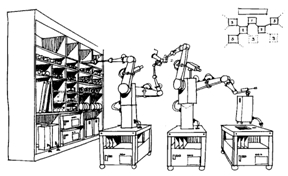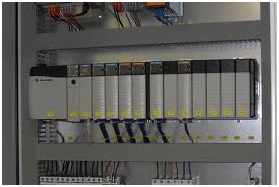Home › Electrical Engineering Forum › General Discussion › Automation Systems
- This topic has 1 reply, 2 voices, and was last updated 10 years, 3 months ago by
denizen360.
-
AuthorPosts
-
2014/01/28 at 2:52 pm #11129
Steven Mill
ParticipantThe subject that is fearful, important, very deep and very open for innovation. Yes we are talking about automation systems or in other words the brain of a system. It is the technology we need.
Everybody needs to learn the basics of it if they want to catch up with the modern industrial systems’ technologies. It is the latest trend. It is great and colorful.
Let’s get inside it: Automation Systems for industry and more.
Introduction
An automation system (or any other control system) consists of two big parts; control and power. The control side is made up from electronic cards and some other small parts. The important side for electricians is the power side.
Today’s technology made it so complex that even if you are an electrician you need to know basic automation so that you are able to deal with the power side of automation systems that work with mid or low voltage levels.
You also have to make sure to not do something wrong with these systems, since they are so expensive and even small voltage changes due to power side can burn whole electronic side and result in lots of money loss to the factory; and I even don’t talk about the money loss due to the suspended system that will make you suffer a lot more.
PLC Systems and technicians
Even a small factory has one or two automation systems now. They may be using old style contactors with the modern PLC systems but they use it. Looking from the factory owner’s side it is very logical for the factories to work with automation systems to make it faster, more economical and even more efficient.
When you call an automation system in industry or any mid or low level electrical application you are probably talking about a PLC system.
PLC systems evolved so much in the modern age and the boxes that hide these systems are becoming smaller and smaller even integrated to the machines like the old style electronic cards. With the help of the integrated circuits’ increasing ability, they made more useful and we have a reality now that we need to learn about this new wave in the industry.
The problems with these PLC systems are mostly about electronic side and we know that some part of it about the power side driven problems. Meaning due to the electrical side there may be problems occurring at the electronic control side.
There are lots of electronic card problems with these automation systems used in industry and most of them requires the change of the electronic card (or main board). And we know that these cards are very hard to repair and we need to pay so much to buy a new change card. As the power system is very powerful and ‘robust’ on the other hand the control side is very fragile.
In addition to the fragile electronic cards, there may be damages to the auxiliary equipment that are attached to the system and even the worst is the injuries due to the automation system not working properly (the partly burned card or low level burned card problems). There may be nonsense behaviors due to electronic burns. So an electrician must be careful and knowledgeable about these systems as well as the power side.
Although this is the case, even the technicians or engineers working with these high-end systems fear to modify them or deal with them. Most of the time in maintenance departments, the case is to call someone from the firm that sets up the system or call someone outside the factory.
To deal with our fear in this field there are courses for automation systems education. You may attend one of these and get the required information to deal with these systems or you may open this problem to the person that is responsible for the education of the department or management of the department to get an educational kit and a trainer.
Since most of the time the employers supports these kind of technical educations that also makes the factory lose less money there won’t be problem.
Smart Grids & Home Automation Systems
In the high voltage electrical distribution field, smart grids are a new, exciting, efficient way of dealing with the distribution of the electricity where computers and the network technologies are used. There are network level and home level developments in the field. At the network side we use smart grids, SCADA systems and at the home side we have smart power meters and home automations.
At the factories there is an intranet of electricity distribution. Sub-grid level smart grids may be used. With the help of a smart grid we are using a smart production. Compensation is a type of smart grid and production if you use automated systems for voltage, frequency and power factor.
There are smart stations for transformers to the factory and you may check the status of the transformer every second.
There are smart distribution systems that can analyze the network of energy distribution and even it can calculate where the system will fail according to the previous data.
At home we have smart power meters and home automations. Smart power meters are very popular these days and we have them everywhere but the home automation systems are not very common due to its being expensive. The energy efficiency due to use home automation that works with the energy levels will cause decrease in the money you paid for the electricity bills.
The home automation system is not something just about closing your curtains remotely.
Home automation is best if it has connection to internet and can get data from internet like weather etc. and modify itself according to these data.
You know there are lots calculations done for the heat efficiency and even curtains can change this calculations and this will result in change in the A/C optimization (see heat pump systems books for more information on calculations.)
Conclusion
The automation systems are the inevitable reality of our field and everybody need to know a little about them not to be outdated. You need to get into it know how it works and at last have ability to use it to make it easier, economical and efficient.
Anyway you need to catch up with the latest developments and keep yourself updated.
Have a good working day with your PLC and let it work for you!
2014/11/02 at 6:34 pm #13544denizen360
Participantwonderful post ..nowadays plc is replaced by DCS.distributed control system (DCS) is a control system for a process or plant, wherein control elements are distributed throughout thesystem. This is in contrast to non-distributed systems, which use a single controller at a central location.
A DCS typically uses custom designed processors as controllers and uses both proprietary interconnections and standard communications protocol for communication. Input and output modules form component parts of the DCS. The processor receives information from input modules and sends information to output modules. The input modules receive information from input instruments in the process (or field) and the output modules transmit instructions to the output instruments in the field.
-
AuthorPosts
- You must be logged in to reply to this topic.


